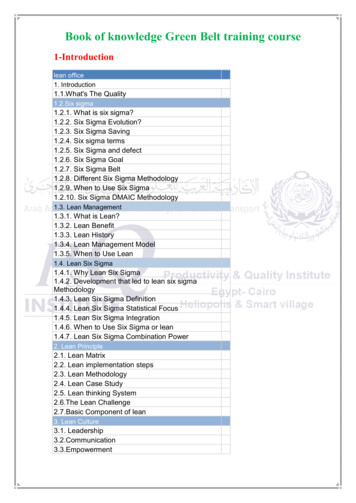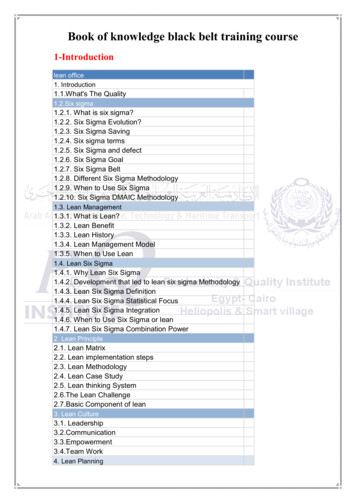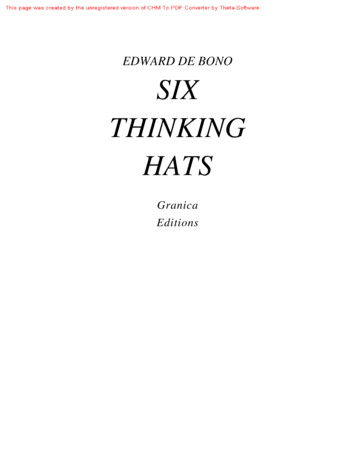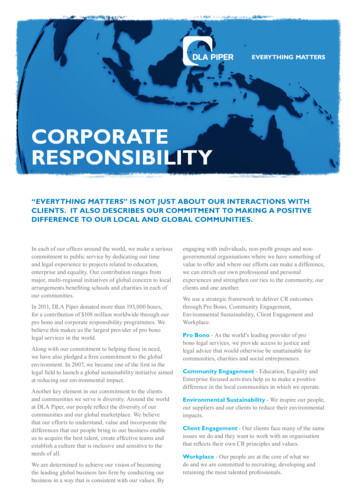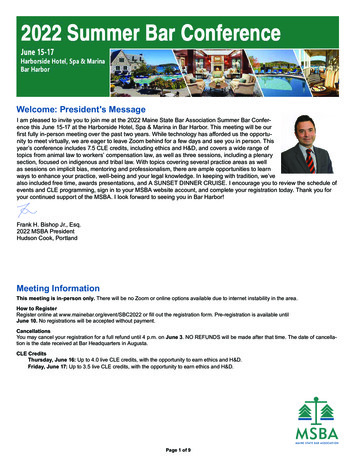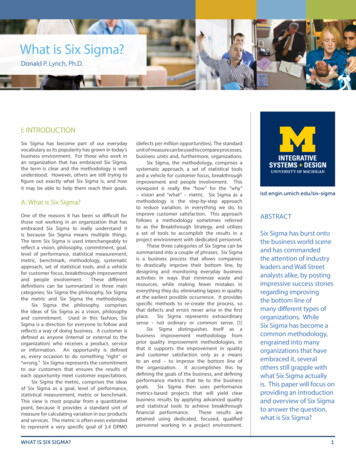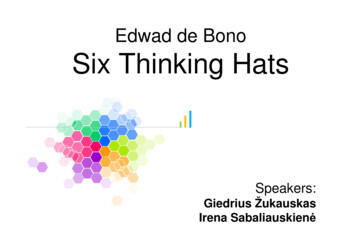
Transcription
Edwad de BonoSix Thinking HatsSpeakers:Giedrius ŽukauskasIrena Sabaliauskienė
About me
Education since 2007 I have a master's degree ineducation management. since 2008 member of the Edward deBono (dBT) community since 2009 certified trainer for Edward deBono techniques (CoRT and SHT)
Profession since 2008 I run a small business trainingcompany (Ltd). Its growing up from then. since 2010 I have been working withbusiness advising companies of the EUstructural support issues. from 2012 I engaged in various businessprojects (new products development,production, etc.).
Personal I have a five and a half years old son,name Ąžuolas. I have won a green card and I lived in USAfor 2 years I like to spend my leisure time with dad inhis garden villa doing reconstruction work(replacing the roof, windows and so on)
About YOUSo I would like to know more about youand your countries
About YOUSo I would like to know more aboutyou (your team) and your country1.Please fill out the forms (3 minutes).2.Then present it to us (3 minutes).
ExpectationsExpectations of this workshop
Expectations1. Discuss your team expectationsof this workshop for 3 min.2. Write it down on a paper leaflet.3. Come and put it on right place.
My tasks for this seminar1. Introduce Edward de Bono'sthinking methods.2. Delivery six thinking hats (SHT)method (theory practice).3. Try to use the SHT in real situation.4. Summarize your experience for theseminar.
Time table14.00 15.30 h.1. Worm up16.00 17.30 h.15.302. dBTmethodology3. SHT theory practice (3 hats)4. SHT theory practice (3 hats)5. Practice16.006. Summarize
Thinking?
Learn how to THINK Edward Charles Francis Publiusde Bono was born in Malta on19 May 1933. Dr Edward de Bono is one ofthe very few people in historywho can be said to have had amajor impact on the way wethink. In many ways he could besaid to be the best knownthinker internationally. He has written numerous bookswith translations into 34languages.
How does it work? I'll give you someprinciples . They could help you tounderstand Edward deBono (dBT) methodsand new thinkingissues.
Simplicity There is nothing complex about Dr.de Bono’s New Thinking methods. He emphasizes that we know and usehis methods instinctively.
Universality Dr. de Bono’s New Thinking methodsare used anywhere and everywhereby people of all ages and abilities. He has rearranged their structure togive them a new meaning and newfocus.
Practicality Dr de Bono’s New Thinking methods aredesigned to be applied; this is thefoundational principle of operacy. They are not theoretical perceptions. Instead, the obligation to effect ourthinking is built into each CoRT ‘tool’ andeach ‘Hat’.
Portability As an ideal, Dr de Bono’s NewThinking methods are infinitelyportable. This means they are sufficientlyflexible and powerful to be used in avariety of situations.
Adaptability The ‘power’ of Dr de Bono’s New Thinkinglies in its interactivity.PMIGreenHatResult
Dr Edward de Bono’sNew Thinking methods They focus on alternatives, what ispossible. They focus on exploring everysituation, listening, sharing,empathy. They encourage the thinker to bepositive and constructive.
Dr Edward de Bono’sNew Thinking methods They are about the generation of aforward-looking vision. They are concerned with design, thegeneration of possibilities andcreativity.
The Six Thinking Hats(SHT)The Six Thinking Hats comprise one of thefive de Bono Thinking ‘frameworks’.
Six Hats Framework
The Six Thinking Hats (SHT) Dr de Bono defines a ‘framework’ as ‘anorganizing and isolating device’. He goes on to explain that once theelements of the framework have beenlearned, understood and applied, they canbe used to direct attention, explicitly, atany issue.
The Six Thinking Hats (SHT) The key value of this framework-basedexplicitness is that thinking is no longercharacterized by drift, moving from onething to another, at random.
Six Hats Framework
The Six Thinking Hats (SHT) Why de Bono use number 6 ? Why he call it hats, not tie ? Why use color ? How you can apply/use thesehats?
Rules for using SHT ACCEPT ideas from others. Do notcriticize or stop them. write all ideas oropinion on a sheet. Use ONE hat at ONE time. All membersshould have time/right to speak. Think DIRECTLY in mode / hat color yourgroup are thinking. Be quick, short andconcentrated.
Rules for using SHT If you or your team member do NOT havemore ideas or opinion, leave it. USEIDEAS you HAVE at THIS MOMNET. Your thinking has to lead to the someRESULT. You have to know how you willuse this RESULT.
Six Thinking HatsData andInformationCaution andJudgmentFeelings andemotionsCreativity andNew IdeasBenefitsOptimismThe thinkingprocess30
YELLOW HATBenefits and Optimism
PurposesThere three main purposes for using : Assessing value, Extracting benefits Making something work.
PurposesAssessing value First, we can use the Yellow Hat as part of an assessment and thenmove to the Black Hat. The Yellow Hat part of the assessment involves listing the goodpoints and the benefits in the proposal or idea. The Black Hat thenexamines the weak points, difficulties and dangers. Using the Yellow Hat in this way is part of making a judgment.
PurposesExtracting benefits Yellow Hat can be used in a deliberateeffort to extract some benefit or goodpoints from something which has generallybeen thought unworkable, unattractive orpotentially a ‘disaster’.
PurposesMaking something work Yellow Hat can be used in an effort to make somethingwork. This is the constructive use of the Yellow Hat. For example, after the Green Hat has put forwardpossibilities, the Yellow Hat may seek to give these asolid basis. This is an active process, not just anassessment.
ExampleYour team need to write a report about thisSHT seminar to all partnership organizationsUse YELLOW HAT in a group . Looking for good points. Looking for benefits
BLACK HATCaution and Judgment
PurposesThe two main purposes for usingthe Black Hat are: To find weaknesses. To make assessments.
Purposes We may use the Black Hat early inour exploration of an idea in orderto find the weaknesses. We find these weaknesses in orderto overcome them and put themright.
Purposes When using the Black Hat to findweaknesses, our goal is to improveon the idea. We may use the Black Hat at theend of an exploration to make anassessment or judgment
ExampleWhen we need the Black Hat to besure we are not making a mistake.
Example Your childrenask you givethem the boatand allowfishing.Use BLACKHAT
RED HATFeelings and emotions
PurposesThere are two main uses of the RedHat: Making feelings known Making assessments and choices
PurposesMaking feelings known At any moment we may signal that we areputting on the Red Hat:"Putting on my Red Hat, I am unhappyabout the demands the community isplacing on our schools."
PurposesMaking feelings known We could have put forward the samefeelings without the Red Hat. It is preciselythe for-mality of labeling the feelings withthe Red Hat, however, that makes thefeelings more acceptable.
PurposesMaking assessments and choices The Black Hat checks out the idea.After this Black Hat thinking, we thenuse the Red Hat: What do I now feelabout the idea?
PurposesMaking assessments and choices The Black Hat checks out the idea.After this Black Hat thinking, we thenuse the Red Hat: What do I now feelabout the idea?
PurposesMaking assessments and choices In choices and decisions, there is anassessment of each alternative with bothYellow and Black Hats. When this hasbeen done and the full picture is available,then it is up to the Red Hat to make thefinal choice.
PurposesMaking assessments and choices What alternative do we like better? Inpractice we may want to recheck with theBlack Hat:This is the alternative I like–let me checkto see whether anything terrible wouldhappen if I went ahead.
ExampleWhat do you think about the weatherin Lithuania?
SHT PRACTICEMovie clip
SHT PRACTICEThere is an idea is to create arunning track for a dog
SHT PRACTICEUse YELLOW , BLACK and REDHATS to speak/make decisionabout it.BenefitsOptimismCaution andJudgmentFeelings andemotions
Coffee brake15.30Iki16.00
WHITE HATData andInformation
PurposesThe main purposes of the White Hat can besummarized in three questions: What information do we have? What information do we need? How do we get the information we need?
Purposes At the beginning of many thinkingtasks, we need information to getstarted. We need information to start thinking.Without information, there can be nothinking.
Example For example, a business would do marketresearch to see if there was a market for anew product.An archaeologist who has formed a theoryabout ‘Civilization x’ will look around tosee if the available information and/orevidence supports the theory.
ExampleYou need to move to the city of PanevėžysUse WHITE HAT in a group to collect information. What information do we have? What information do we need? How do we get the information we need?
THE GREEN HATCreativity and new Ideas
Purposes The main purpose of Green Hat thinkingis to be generative, productive and tomove thinking forward. Finding completely new ideas is only onemeans of making progress.
PurposesLook at main activities of Green Hatthinking: Generating reactive ideas.Generating starting ideas.Generating further and better ideas.Generating new ideas.
Purposes Green Hat thinking can help when we need totake an action, provide an explanation,forecast an outcome or design something newto fit a need. The overall question for Green Hat thinkingis: What ideas do we have?
ExampleYour group need to get to airport tonight.But there is no bus or train going latetime. What ideas do you have?
THE BLUE HATThe thinking processPage 66
Purposes The Blue Hat is most often used at thebeginning, in the middle and at the endof a thinking session. Some key wordsto describe the use of the Blue Hat arefocus, purpose, agenda, observations,next step, outcome and summary.
Purposes With the Blue Hat we try to takecharge of our thinking in order toorganize what is going on. The BlueHat is like the conductor of theorchestra who organizes what theinstruments are playing at anymoment.
PurposesThree questions to ask with the BlueHat are: What thinking has been done? What's our thinking goal? What is the next step to reach the goal?”
PurposesThree questions to ask with the BlueHat are: What thinking has been done? What's our thinking goal? What is the next step to reach the goal?”
PurposesThe five main uses include: Defining focus and purpose.Setting out a thinking agenda.Making observations and comments.Deciding the next step.Defining outcomes and summarizing.
ExamplesGiedrius is hardly tractable child. Youare parent and want to propose anew idea but you are afraid ofjudgment. How your group will organize an interviewwith him? What hats you will use for thispurpose?
SHT PRACTICEMovie clip
SHT PRACTICEYou must provide an explanationwhy the cat did not listenhedgehog.
SHT PRACTICEUse WHITE , GREEN and BLUEhats to speak/make decisionabout it.Data andInformationCreativity andNew IdeasThe thinkingprocess
Six Thinking Hats: SimpleSequencesThe Hat definitionsrefer to sequences,one Hat being usedforaspecificpurposethenfollowed by another.
Six Thinking Hats: SimpleSequences- explanationData andInformationCreativity andNew Ideas
Six Thinking Hats: SimpleSequencesExplanation introduces thematter of individualperception and a chance toresolve related matters. The White Hat asks: What do we know about thesituation? The Green Hat asks: What are the possibleexplanations?
Six Thinking Hats: SimpleSequences- ChoiceBenefits Caution andOptimism JudgmentFeelings andemotions
Six Thinking Hats: SimpleSequencesThe final choice dependson our feelings, whichmeans the application ofour values—what we thinkis important. The Yellow Hat asks: What are the good points? The Black Hat asks: What are the difficulties anddangers? The Red Hat asks: How do we feel about this?
DESISION MAKINGPRACTICEMake adecision byusing SHTmethods.
DESISION MAKINGPRACTICESITUATION: If your group want to get certificates andfounding for participating in this seminarYOU MUST stay till 19.00 and do a test. No test - no founding from The LifelongLearning Program. But you have other activities from 18.00h.
DESISION MAKINGPRACTICE 10 minutes for decision 5 minutes for summarizingexperience in groups 2 minutes for report
Make a desition by usingSHT methods.Data andInformationCaution andJudgementFeelings andemotionsCreativity andNew IdeasBenefitsOptimizmThe thinkingproces
Conclusions
ConclusionsPlease find and write the answersto the following questionsin your group (6 min)
ConclusionsConsidering this 3 hours work shop Pleasefind and write the answers to the followingquestions in your group:A. Your feelings and emotionsB. Your understanding and main valueC.Your misunderstanding and uncertainty
The Six Thinking Hats (SHT) Dr de Bono defines a 'framework' as 'an organizing and isolating device'. He goes on to explain that once the elements of the framework have been learned, understood and applied, they can be used to direct attention, explicitly, at


